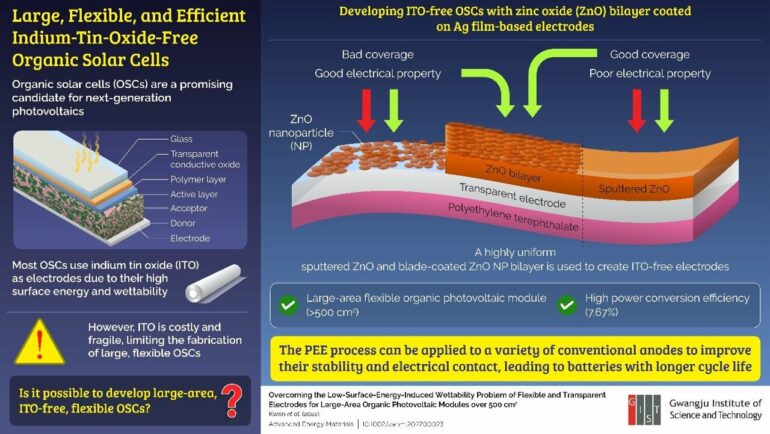Organic solar cells (OSCs), which make use of organic materials to convert sunlight into electricity, are an attractive candidate for future photovoltaics. This is due to several of their desirable features, such as their light weight, flexibility, malleability, and, most importantly, high power conversion efficiency (PCE). Such qualities make them ideal for a wide range of applications.
Despite their massive commercialization potential, however, there is a catch. Most OSCs are produced using a technique called “spin coating,” which allows for high PCEs but makes for poor scalability. Additionally, OSCs with flexible electrodes use indium tin oxide (ITO), which makes them expensive and too fragile for realizing large-area modules. Thus, if the commercial promise of OSCs is to be realized, they must overcome their dependence on ITO.
This is where Dr. Hongkyu Kang and Prof. Kwanghee Lee from the Gwangju Institute of Science and Technology (GIST) in Korea come in. In their paper in Advanced Energy Materials they put forth a new method to create OSCs using zinc oxide (ZnO) that overcame the issues of cost and scalability without comprising the PCE.
In particular, this research was the result of an industry-university collaboration, in which GIST developed the original technology for the first time in Korea and transferred it to MSWAY Co., Ltd., which had been entirely dependent on foreign imports as the domestic production of ITO-based electrodes was impracticable. With the new technology, it is expected that a value chain will be established for the commercialization of OSCs with construction and equipment companies, strengthening the value of industry-university joint research.
The team used sputtered ZnO and a ZnO nanoparticle layer obtained through a “blade coating” technique to create a uniform bilayer on an ultrathin silver film electrode. “The ultrathin silver film electrode with ZnO bilayer has the flexibility, wettability, and high surface energy of ITO but is not brittle or expensive. This makes it easier to use ZnO for manufacturing organic solar cells and developing a printing technology for large-area solar cell technology,” says Dr. Kang.
The new ZnO bilayer-based OSCs demonstrated an efficiency of 7.67% for a module area of 528 cm2, which makes it the most efficient large-area OSC when compared to previous research. This was due to the reduction of “recombination” of charge carriers in OSCs by the crystalline ZnO nanoparticles that, in turn, improved their open-circuit voltage, i.e., PCE.
The creation of these ITO-free OSCs with a large area and the same flexibility and efficiency as that of ITO-based OSCs can be a game changer for the future of solar cell technology. “Our method opens doors to the commercial use of these OSCs, such as their integration into building walls and windows to realize self-sustaining buildings,” says Prof. Lee. Indeed, the superiority of large-area OSCs in terms of commercial potential and efficiency can usher in a new age of power generation and help us in the fight against climate change.
More information:
Hyeok‐Chan Kwon et al, Overcoming the Low‐Surface‐Energy‐Induced Wettability Problem of Flexible and Transparent Electrodes for Large‐Area Organic Photovoltaic Modules over 500 cm 2, Advanced Energy Materials (2022). DOI: 10.1002/aenm.202200023
Provided by
GIST (Gwangju Institute of Science and Technology)
Citation:
Scientists realize large-area organic solar cells that are low-cost, flexible, and efficient (2022, August 16)



